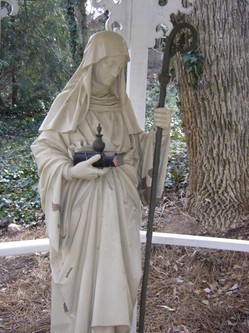O God, the boundless generosity of your favor is proclaimed by the wonders you have worked in your holy women. As we are taught by your holy virgin Walburga's example of purity and rejoice in the glory of her miracles, may she be our patron to gain for us your unfailing love.
One of the important Benedictine saints in the Church is the 8th century Saint Walburga and yet she is relatively unknown to many outside the world of monks and nuns. Her story is found here. You might find it interesting to note that Saint Walburga's relative is the Apostle to
In
 Since 1857, the Benedictine sisters of Elizabeth, NJ, also claim Saint Walburga as their patron.
Since 1857, the Benedictine sisters of Elizabeth, NJ, also claim Saint Walburga as their patron.
Also, we should mention the venerable witness of Saint Walburg Monastery in
Belmont Abbey's secondary patron is Saint Walburga. No fewer than two statues, one in the monastery and one in the grotto honor the saint. Plus, the monks honored the saint with a beautiful stained glass window in the Abbey Basilica.
The novena prayer to Saint Walburga
Holy Walburga, you dwell in the glory of heaven, gazing upon the face of the Triune God in the company of all the saints. I turn to you, full of trust in the words of Jesus Christ, "Amen, amen I say to you, the one who has faith in me will do the works I do, and greater far than these" (John
Ask this for me through Jesus Christ, our Lord, who lives and reigns in the unity of the Father and the Holy Spirit, one God for ever and ever. Amen.


Also there is St. Walburg Monastery in Covington, Kentucky. We are directly descended from St. Walburg Abbey in Eichstatt, Germany and are celebrating the 150th anniversary of our founding this year. See www.stwalburg.org.
Thanks, Sister Deborah, for pointing this fact out. I am grateful that you took the time to email me and that you are reading the blog. I will make the correction in the blog entry for Saint Walburga shortly.
I am interested in the St. Wallburg Abbey in Convinton, KY that taught art, especially ceramic painting around 1908 or earlier. My grandmother was a student in these classes and I am trying to learn more about the history behind the pieces I inherited.
HI Mary, I am not much on this matter. My supposition is that the abbey's archives may maintain the files of the sisters who taught school. These files, if they in fact exist, may contain methodology and notes on Benedictine pedagogy. Having said that, there may be not systematic expositions on "Benedictine pedagogy" of the early 20th century relating to grammar schools administered by Benedictine sisters.
In any case, write to the Prioress of St Walburga's presenting your interest asking her to put you in touch with the archivist who may know something, or may know how to proceed.
Thanks for reading Communio blog. PAX!